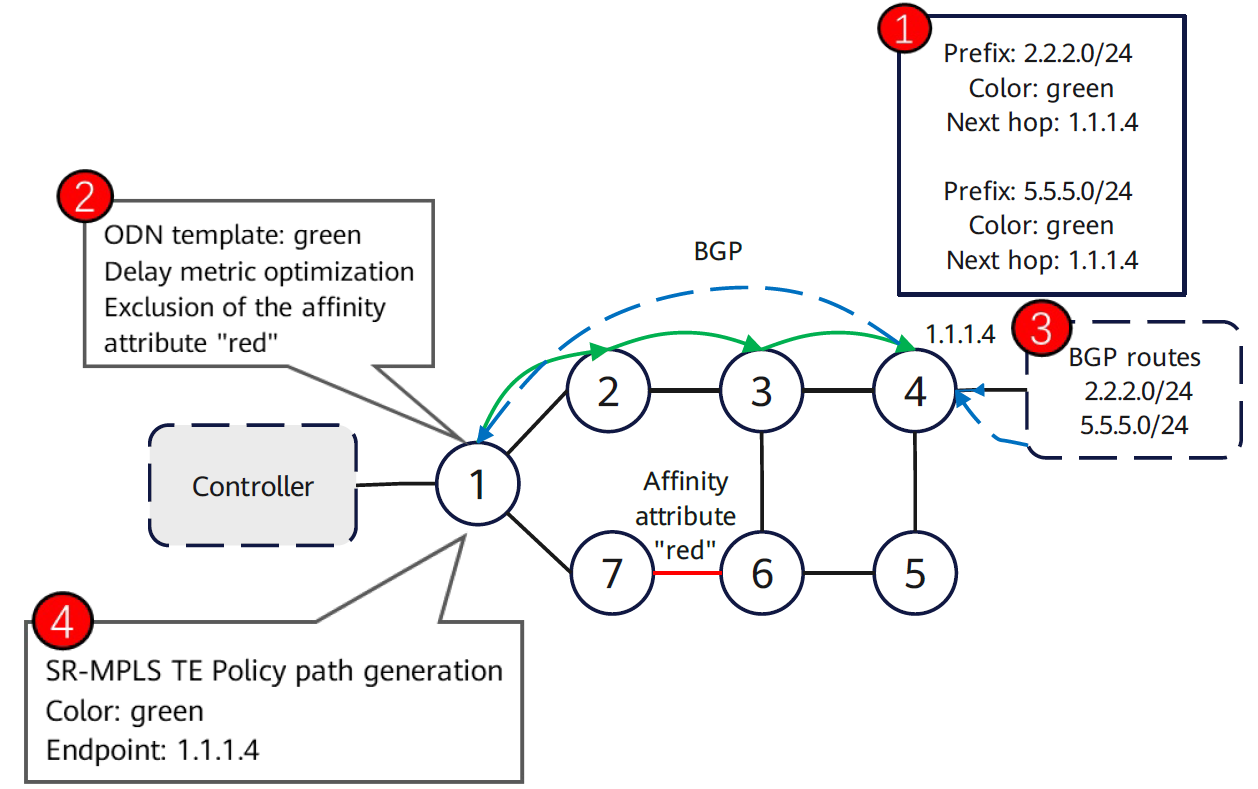What Is ODN?
On-demand next hop (ODN) is used to dynamically generate desired SR-MPLS TE Policies based on a template containing specified path requirements on the headend. This function enables you to quickly respond to service requirements without the need to manually configure SR-MPLS TE Policies.
Why Do We Need ODN?
Typically, to implement color-based traffic steering into an SR-MPLS TE Policy, you need to preconfigure the SR-MPLS TE Policy manually or use a controller to deliver the SR-MPLS TE Policy to the headend. During route recursion, the headend checks whether the color and next hop of the involved BGP route match the color and endpoint, respectively, of an existing SR-MPLS TE Policy. If they match, the route can recurse to the SR-MPLS TE Policy. In this recursion mode, if no route recurses to a preconfigured SR-MPLS TE Policy, the SR-MPLS TE Policy is wasted.
The on-demand next hop (ODN) function does not require a large number of SR-MPLS TE Policies to be configured in advance. Instead, it enables SR-MPLS TE Policy creation to be dynamically triggered on demand based on service routes, making network operations much easier.
How Does ODN Work?
In scenarios where SR-MPLS TE Policies are generated through ODN, a controller is required. Forwarders on the network need to establish BGP-LS peer relationships with the controller, which can then compute SR-MPLS TE Policies based on network topology, label, and other information reported by the forwarders through BGP-LS.
The main process of generating an SR-MPLS TE Policy through ODN is as follows:
1. A group of ODN templates are preconfigured on the headend based on the required SLAs, with each ODN template corresponding to the color value of an SLA. The ODN templates define characteristics for the candidate paths to be generated, such as the path preferences, whether the paths need to be dynamically generated, which metric needs to be optimized if the paths are dynamically generated, and path constraints.
2. After receiving BGP service routes, the endpoint adds the color attribute specified through route-policy configuration to the routes based on service SLA requirements. Each type of color attribute represents a type of SLA requirement (e.g., requiring low-delay or high-bandwidth paths) for service routes.
3. The endpoint advertises the service routes to the headend through the BGP peer relationship. In this case, the routes carry the color attribute, and their next hops are both set to the endpoint address.
4. After receiving the BGP service routes, the headend matches the color attribute of the routes against the color value defined in the locally configured ODN template. If they are matched, the headend sends a path computation request to the controller through Path Computation Element Communication Protocol (PCEP). After receiving the request, the controller starts computing an SR-MPLS TE Policy path, and then delivers the computed path to the headend through PCEP for service forwarding.
The key to ODN is to add the color attribute to each BGP service route, a process known as coloring. Using the network shown in the preceding figure as an example, the endpoint — node 4 — colors BGP service routes 2.2.2.0/24 and 5.5.5.0/24 green (assuming that this template indicates requirements for low-delay paths). After the headend — node 1 — receives the BGP routes, the controller finds that the color attribute carried in the routes matches the color value defined in the locally configured ODN template. As such, the controller uses the next-hop address 1.1.1.4 of the BGP routes as the endpoint address to compute a low-delay SR-MPLS TE Policy path and then delivers the path to node 1.
After all BGP service routes that match the green color on the headend are withdrawn, the headend tears down the candidate path generated through ODN. If no other candidate paths are available, the headend also tears down the corresponding SR-MPLS TE Policy.
ODN Applications
ODN is mainly used to dynamically allocate and optimize network resources by leveraging automated network deployment and the flexible network architecture. In ODN, routers are managed and controlled using a controller. When new traffic arrives, the controller sends the traffic to an available router based on a certain policy. This flexible network architecture enables ODN to support diversified network service requirements in a wide range of scenarios.
ODN is widely used, especially in the data centers of large enterprises and organizations. This function helps such enterprises and organizations implement automated network deployment and resource optimization, thereby improving network performance and scalability and reducing network O&M costs.
- Author: Qiao Dan
- Updated on: 2023-11-29
- Views: 908
- Average rating:








